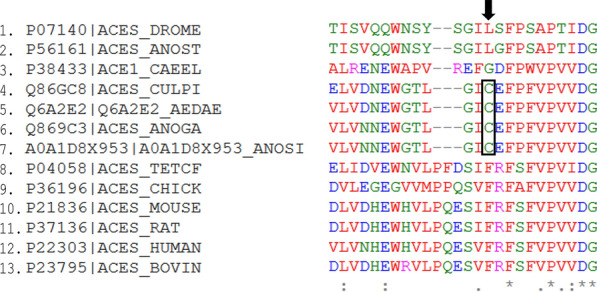Fig. 4.

Conserved unpaired cysteine residue in the acetylcholinesterase (AChE) of disease vectors for selective insecticide design. The sequences shown are from Drosophila melanogaster (DROME), Tetronarce californica (TETCF), Mus musculus (MOUSE), Homo sapiens (HUMAN), Bos taurus (BOVIN), Rattus norvegicus (RAT), Caenorhabditis elegans (CAEEL), Anopheles stephensi (ANOST), An. gambiae (ANOGA), Culex pipiens (CULPI), An. sinensis (ANOSI), Aedes aegypti (AEDAE). The name of each organism starts with its UniProt accession number. The black arrow points to the position of the conserved unpaired cysteine residue. The unpaired cysteine residue is conserved in disease vectors (4–7). This residue is substituted by a leucine residue in An. stephensi and Drosophila AChE (1–2), phenylalanine residues in mammals, fish and bird AChE (8–13), and a glycine residue in nematode AChE (3). This unpaired cysteine could be targeted for the development of more selective and specific insecticides. * indicates positions that have single and conserved amino acid residues; : indicates conservation between amino acid residues of strongly similar properties; . indicates conservation between amino acid residues of weakly similar properties
